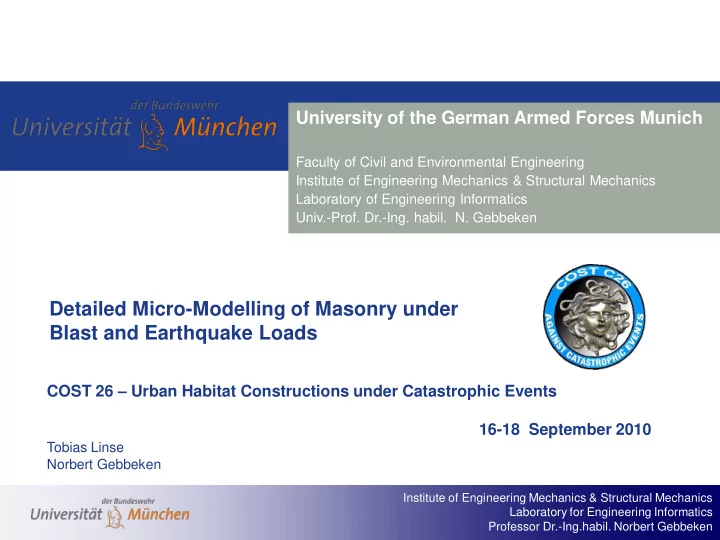

University of the German Armed Forces Munich Faculty of Civil and Environmental Engineering Institute of Engineering Mechanics & Structural Mechanics Laboratory of Engineering Informatics Univ.-Prof. Dr.-Ing. habil. N. Gebbeken Detailed Micro-Modelling of Masonry under Blast and Earthquake Loads COST 26 – Urban Habitat Constructions under Catastrophic Events 16-18 September 2010 Tobias Linse Norbert Gebbeken Institute of Engineering Mechanics & Structural Mechanics Laboratory for Engineering Informatics Professor Dr.-Ing.habil. Norbert Gebbeken
Masonry under (high-) dynamic Loadings Einwirkungen: Explosionen / Detonationen Explosions, Impact, Earthquakes Assessment for masonry constructions worldwide e.g. for Embassies, Police departments Buildings for aid organizations Ordinary new and historic constructions Institute of Engineering Mechanics & Structural Mechanics Laboratory for Engineering Informatics Professor Dr.-Ing.habil. Norbert Gebbeken
Types of Masonry Materials – Assembly – big variety clay – adobe quarry stones clinker bricks concrete Institute of Engineering Mechanics & Structural Mechanics Laboratory for Engineering Informatics Professor Dr.-Ing.habil. Norbert Gebbeken
Failure modes of masonry Bending-Failure Failure due to high vertical load Shear-Failure Institute of Engineering Mechanics & Structural Mechanics Laboratory for Engineering Informatics Professor Dr.-Ing.habil. Norbert Gebbeken
Failure Modes of Masonry Horizontal uniaxial Vertical uniaxial Biaxial loading loading loading - Failure of the masonry - Tensile failure of the “stairway” failure of the - units under tension or masonry units or mortar joints compression joints - Biaxial failure of the - Shear failure of the bed - Failure under compression masonry units joint of the masonry units because of lateral tension Institute of Engineering Mechanics & Structural Mechanics Laboratory for Engineering Informatics Professor Dr.-Ing.habil. Norbert Gebbeken
Failure Mechanism due to lateral deformation of the joints s x / s y Jacketed projectiles with hard cores (Silling 2007) Compression Tension Institute of Engineering Mechanics & Structural Mechanics Laboratory for Engineering Informatics Professor Dr.-Ing.habil. Norbert Gebbeken
Failure mechanism horizontal Load Institute of Engineering Mechanics & Structural Mechanics Laboratory for Engineering Informatics Professor Dr.-Ing.habil. Norbert Gebbeken
Modelling Masonry - Strategies Institute of Engineering Mechanics & Structural Mechanics Laboratory for Engineering Informatics Professor Dr.-Ing.habil. Norbert Gebbeken
Elements of a dynamic material model strength model elastic limit shear yield surface residual strength Equation of State pressure influence of pressure – volumetric strain rate dependent effects of loading rate damage Model decrease of shear modulus and strength Institute of Engineering Mechanics & Structural Mechanics Laboratory for Engineering Informatics Professor Dr.-Ing.habil. Norbert Gebbeken
Material models for Masonry Ganz„s model - macro model - several fracture surfaces - in plane loadings of the wall Lourenço„s material model: Lourenco and Rots Journal Engineering Mohr-Coulomb with Mechanics 1997 [GANZ 1985] „Tension Cut Off“ [LOURENCO and ROTS 1997] Institute of Engineering Mechanics & Structural Mechanics Laboratory for Engineering Informatics Professor Dr.-Ing.habil. Norbert Gebbeken
Mortar - residual material strength – compressive meridian s v s r residual strenght depends on the stress state! [BIERWIRTH 1995] Fracture residual strenght strenght Institute of Engineering Mechanics & Structural Mechanics Laboratory for Engineering Informatics Professor Dr.-Ing.habil. Norbert Gebbeken
Mortar - residual material strength – shear meridian vertical load [WALLNER 2008] displacement residual Fracture strenght strenght Institute of Engineering Mechanics & Structural Mechanics Laboratory for Engineering Informatics Professor Dr.-Ing.habil. Norbert Gebbeken
Mortar - residual material strength – shear meridian [WALLNER 2008] Institute of Engineering Mechanics & Structural Mechanics Laboratory for Engineering Informatics Professor Dr.-Ing.habil. Norbert Gebbeken
Mortar - residual material strength Institute of Engineering Mechanics & Structural Mechanics Laboratory for Engineering Informatics Professor Dr.-Ing.habil. Norbert Gebbeken
Fracture surface for mortar Functions to interpolate between meridians Institute of Engineering Mechanics & Structural Mechanics Laboratory for Engineering Informatics Professor Dr.-Ing.habil. Norbert Gebbeken
Mortar - dynamic material properties – HAO‟s tests DIF – Dynamic Increase Factor strain rate Institute of Engineering Mechanics & Structural Mechanics Laboratory for Engineering Informatics Professor Dr.-Ing.habil. Norbert Gebbeken
Material model Masonry Unit William-Warnke strength model with „Tension Cut Off“ Strain rate dependent (Hao) Residual resistance controlled by damage Model Damage Model is based on actual and maximal plastic Strain Equation of State Linear EOS Institute of Engineering Mechanics & Structural Mechanics Laboratory for Engineering Informatics Professor Dr.-Ing.habil. Norbert Gebbeken
Own material tests Objective: Create a Database to be able to characterize different masonry units rapidly Tests on single units: - Uniaxial compression with cyclic loading - Tension-, Bending-, Wedge-cleaving-test - Density / Porosity - Wave speed Tests on masonry specimens: 5 units with 4 mortal joints Institute of Engineering Mechanics & Structural Mechanics Laboratory for Engineering Informatics Professor Dr.-Ing.habil. Norbert Gebbeken
Numerical Simulation of Masonry Walls different support conditions can be taken into account Shear failure Bending failure Combined Failure Mechanism Support conditions play an important role! Institute of Engineering Mechanics & Structural Mechanics Laboratory for Engineering Informatics Professor Dr.-Ing.habil. Norbert Gebbeken
Numerical simulation of Blast Tests Masonry in steel frame Different thicknesses Different masonry types Loaded by blast wave Objective: Realistic results with numerical simulations Institute of Engineering Mechanics & Structural Mechanics Laboratory for Engineering Informatics Professor Dr.-Ing.habil. Norbert Gebbeken
University of the German Armed Forces Munich Faculty of Civil and Environmental Engineering Institute of Engineering Mechanics & Structural Mechanics Laboratory of Engineering Informatics Univ.-Prof. Dr.-Ing. habil. N. Gebbeken Thank you for your attention! Detailed Micro-Modelling of Masonry under Blast and Earthquake Loads COST 26 – Urban Habitat Constructions under Catastrophic Events, 16-18 September 2010 Tobias Linse, Norbert Gebbeken
Recommend
More recommend